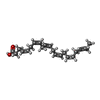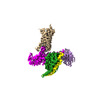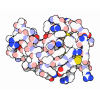+ Open data
Open data
- Basic information
Basic information
| Entry |  | |||||||||
|---|---|---|---|---|---|---|---|---|---|---|
| Title | Structure of FFAR1-Gq complex bound to DHA | |||||||||
 Map data Map data | ||||||||||
 Sample Sample |
| |||||||||
 Keywords Keywords | FFAR1 / FFAs / diabetes / CryoEM / MEMBRANE PROTEIN | |||||||||
| Function / homology |  Function and homology information Function and homology informationbioactive lipid receptor activity / Free fatty acid receptors / Fatty Acids bound to GPR40 (FFAR1) regulate insulin secretion / Synthesis, secretion, and inactivation of Glucose-dependent Insulinotropic Polypeptide (GIP) / response to fatty acid / positive regulation of calcium ion transport / insulin secretion / negative regulation of interleukin-1 beta production / ligand-gated ion channel signaling pathway / viral release from host cell by cytolysis ...bioactive lipid receptor activity / Free fatty acid receptors / Fatty Acids bound to GPR40 (FFAR1) regulate insulin secretion / Synthesis, secretion, and inactivation of Glucose-dependent Insulinotropic Polypeptide (GIP) / response to fatty acid / positive regulation of calcium ion transport / insulin secretion / negative regulation of interleukin-1 beta production / ligand-gated ion channel signaling pathway / viral release from host cell by cytolysis / peptidoglycan catabolic process / G protein-coupled receptor activity / positive regulation of insulin secretion / Olfactory Signaling Pathway / Activation of the phototransduction cascade / G beta:gamma signalling through PLC beta / Presynaptic function of Kainate receptors / Thromboxane signalling through TP receptor / G protein-coupled acetylcholine receptor signaling pathway / Activation of G protein gated Potassium channels / Inhibition of voltage gated Ca2+ channels via Gbeta/gamma subunits / G-protein activation / Prostacyclin signalling through prostacyclin receptor / G beta:gamma signalling through CDC42 / cell wall macromolecule catabolic process / Glucagon signaling in metabolic regulation / G beta:gamma signalling through BTK / Synthesis, secretion, and inactivation of Glucagon-like Peptide-1 (GLP-1) / ADP signalling through P2Y purinoceptor 12 / photoreceptor disc membrane / Sensory perception of sweet, bitter, and umami (glutamate) taste / Glucagon-type ligand receptors / Adrenaline,noradrenaline inhibits insulin secretion / Vasopressin regulates renal water homeostasis via Aquaporins / lysozyme / Glucagon-like Peptide-1 (GLP1) regulates insulin secretion / G alpha (z) signalling events / lysozyme activity / cellular response to catecholamine stimulus / ADORA2B mediated anti-inflammatory cytokines production / ADP signalling through P2Y purinoceptor 1 / G beta:gamma signalling through PI3Kgamma / adenylate cyclase-activating dopamine receptor signaling pathway / Cooperation of PDCL (PhLP1) and TRiC/CCT in G-protein beta folding / GPER1 signaling / Inactivation, recovery and regulation of the phototransduction cascade / cellular response to prostaglandin E stimulus / glucose homeostasis / G-protein beta-subunit binding / heterotrimeric G-protein complex / G alpha (12/13) signalling events / sensory perception of taste / extracellular vesicle / signaling receptor complex adaptor activity / Thrombin signalling through proteinase activated receptors (PARs) / retina development in camera-type eye / positive regulation of cytosolic calcium ion concentration / GTPase binding / Ca2+ pathway / fibroblast proliferation / High laminar flow shear stress activates signaling by PIEZO1 and PECAM1:CDH5:KDR in endothelial cells / G alpha (i) signalling events / G alpha (s) signalling events / phospholipase C-activating G protein-coupled receptor signaling pathway / G alpha (q) signalling events / Ras protein signal transduction / host cell cytoplasm / Extra-nuclear estrogen signaling / cell population proliferation / defense response to bacterium / G protein-coupled receptor signaling pathway / lysosomal membrane / GTPase activity / synapse / lipid binding / protein-containing complex binding / signal transduction / extracellular exosome / membrane / plasma membrane / cytoplasm / cytosol Similarity search - Function | |||||||||
| Biological species |  Homo sapiens (human) Homo sapiens (human) | |||||||||
| Method | single particle reconstruction / cryo EM / Resolution: 2.8 Å | |||||||||
 Authors Authors | Kumari P / Inoue A / Chapman K / Lian P / Rosenbaum DM | |||||||||
| Funding support |  United States, 1 items United States, 1 items
| |||||||||
 Citation Citation |  Journal: Proc Natl Acad Sci U S A / Year: 2023 Journal: Proc Natl Acad Sci U S A / Year: 2023Title: Molecular mechanism of fatty acid activation of FFAR1. Authors: Punita Kumari / Asuka Inoue / Karen Chapman / Peng Lian / Daniel M Rosenbaum /   Abstract: FFAR1 is a G-protein-coupled receptor (GPCR) that responds to circulating free fatty acids to enhance glucose-stimulated insulin secretion and release of incretin hormones. Due to the glucose- ...FFAR1 is a G-protein-coupled receptor (GPCR) that responds to circulating free fatty acids to enhance glucose-stimulated insulin secretion and release of incretin hormones. Due to the glucose-lowering effect of FFAR1 activation, potent agonists for this receptor have been developed for the treatment of diabetes. Previous structural and biochemical studies of FFAR1 showed multiple sites of ligand binding to the inactive state but left the mechanism of fatty acid interaction and receptor activation unknown. We used cryo-electron microscopy to elucidate structures of activated FFAR1 bound to a G mimetic, which were induced either by the endogenous FFA ligand docosahexaenoic acid or γ-linolenic acid and the agonist drug TAK-875. Our data identify the orthosteric pocket for fatty acids and show how both endogenous hormones and synthetic agonists induce changes in helical packing along the outside of the receptor that propagate to exposure of the G-protein-coupling site. These structures show how FFAR1 functions without the highly conserved "DRY" and "NPXXY" motifs of class A GPCRs and also illustrate how the orthosteric site of a receptor can be bypassed by membrane-embedded drugs to confer full activation of G protein signaling. | |||||||||
| History |
|
- Structure visualization
Structure visualization
| Supplemental images |
|---|
- Downloads & links
Downloads & links
-EMDB archive
| Map data |  emd_28164.map.gz emd_28164.map.gz | 28.5 MB |  EMDB map data format EMDB map data format | |
|---|---|---|---|---|
| Header (meta data) |  emd-28164-v30.xml emd-28164-v30.xml emd-28164.xml emd-28164.xml | 24 KB 24 KB | Display Display |  EMDB header EMDB header |
| FSC (resolution estimation) |  emd_28164_fsc.xml emd_28164_fsc.xml | 7.1 KB | Display |  FSC data file FSC data file |
| Images |  emd_28164.png emd_28164.png | 44.9 KB | ||
| Filedesc metadata |  emd-28164.cif.gz emd-28164.cif.gz | 7.6 KB | ||
| Others |  emd_28164_half_map_1.map.gz emd_28164_half_map_1.map.gz emd_28164_half_map_2.map.gz emd_28164_half_map_2.map.gz | 23.4 MB 23.4 MB | ||
| Archive directory |  http://ftp.pdbj.org/pub/emdb/structures/EMD-28164 http://ftp.pdbj.org/pub/emdb/structures/EMD-28164 ftp://ftp.pdbj.org/pub/emdb/structures/EMD-28164 ftp://ftp.pdbj.org/pub/emdb/structures/EMD-28164 | HTTPS FTP |
-Related structure data
| Related structure data |  8eitMC  8ejcC  8ejkC M: atomic model generated by this map C: citing same article ( |
|---|---|
| Similar structure data | Similarity search - Function & homology  F&H Search F&H Search |
- Links
Links
| EMDB pages |  EMDB (EBI/PDBe) / EMDB (EBI/PDBe) /  EMDataResource EMDataResource |
|---|---|
| Related items in Molecule of the Month |
- Map
Map
| File |  Download / File: emd_28164.map.gz / Format: CCP4 / Size: 30.5 MB / Type: IMAGE STORED AS FLOATING POINT NUMBER (4 BYTES) Download / File: emd_28164.map.gz / Format: CCP4 / Size: 30.5 MB / Type: IMAGE STORED AS FLOATING POINT NUMBER (4 BYTES) | ||||||||||||||||||||||||||||||||||||
|---|---|---|---|---|---|---|---|---|---|---|---|---|---|---|---|---|---|---|---|---|---|---|---|---|---|---|---|---|---|---|---|---|---|---|---|---|---|
| Projections & slices | Image control
Images are generated by Spider. | ||||||||||||||||||||||||||||||||||||
| Voxel size | X=Y=Z: 1.08 Å | ||||||||||||||||||||||||||||||||||||
| Density |
| ||||||||||||||||||||||||||||||||||||
| Symmetry | Space group: 1 | ||||||||||||||||||||||||||||||||||||
| Details | EMDB XML:
|
-Supplemental data
-Half map: #2
| File | emd_28164_half_map_1.map | ||||||||||||
|---|---|---|---|---|---|---|---|---|---|---|---|---|---|
| Projections & Slices |
| ||||||||||||
| Density Histograms |
-Half map: #1
| File | emd_28164_half_map_2.map | ||||||||||||
|---|---|---|---|---|---|---|---|---|---|---|---|---|---|
| Projections & Slices |
| ||||||||||||
| Density Histograms |
- Sample components
Sample components
-Entire : Free Fatty Acid Receptor1- G-Protein complex
| Entire | Name: Free Fatty Acid Receptor1- G-Protein complex |
|---|---|
| Components |
|
-Supramolecule #1: Free Fatty Acid Receptor1- G-Protein complex
| Supramolecule | Name: Free Fatty Acid Receptor1- G-Protein complex / type: complex / ID: 1 / Parent: 0 / Macromolecule list: #1-#5 |
|---|---|
| Source (natural) | Organism:  Homo sapiens (human) Homo sapiens (human) |
-Macromolecule #1: A modified Guanine nucleotide-binding protein G(q) subunit alpha
| Macromolecule | Name: A modified Guanine nucleotide-binding protein G(q) subunit alpha type: protein_or_peptide / ID: 1 / Number of copies: 1 / Enantiomer: LEVO |
|---|---|
| Source (natural) | Organism:  Homo sapiens (human) Homo sapiens (human) |
| Molecular weight | Theoretical: 27.638461 KDa |
| Recombinant expression | Organism:  |
| Sequence | String: MGSTLSAEDK AAVERSKMID RNLREDGEKA RRTLRLLLLG ADNSGKSTIV KQMRILHTSG IFETKFQVDK VNFHMFDVGG QRDERRKWI QCFNDVTAII FVVDSSDYNR LQEALNDFKS IWNNRWLRTI SVILFLNKQD LLAEKVLAGK SKIEDYFPEF A RYTTPEDA ...String: MGSTLSAEDK AAVERSKMID RNLREDGEKA RRTLRLLLLG ADNSGKSTIV KQMRILHTSG IFETKFQVDK VNFHMFDVGG QRDERRKWI QCFNDVTAII FVVDSSDYNR LQEALNDFKS IWNNRWLRTI SVILFLNKQD LLAEKVLAGK SKIEDYFPEF A RYTTPEDA TPEPGEDPRV TRAKYFIRKE FVDISTASGD GRHICYPHFT CAVDTENARR IFNDCKDIIL QMNLREYNLV |
-Macromolecule #2: Guanine nucleotide-binding protein G(I)/G(S)/G(T) subunit beta-1
| Macromolecule | Name: Guanine nucleotide-binding protein G(I)/G(S)/G(T) subunit beta-1 type: protein_or_peptide / ID: 2 / Number of copies: 1 / Enantiomer: LEVO |
|---|---|
| Source (natural) | Organism:  Homo sapiens (human) Homo sapiens (human) |
| Molecular weight | Theoretical: 37.41693 KDa |
| Recombinant expression | Organism:  |
| Sequence | String: MSELDQLRQE AEQLKNQIRD ARKACADATL SQITNNIDPV GRIQMRTRRT LRGHLAKIYA MHWGTDSRLL VSASQDGKLI IWDSYTTNK VHAIPLRSSW VMTCAYAPSG NYVACGGLDN ICSIYNLKTR EGNVRVSREL AGHTGYLSCC RFLDDNQIVT S SGDTTCAL ...String: MSELDQLRQE AEQLKNQIRD ARKACADATL SQITNNIDPV GRIQMRTRRT LRGHLAKIYA MHWGTDSRLL VSASQDGKLI IWDSYTTNK VHAIPLRSSW VMTCAYAPSG NYVACGGLDN ICSIYNLKTR EGNVRVSREL AGHTGYLSCC RFLDDNQIVT S SGDTTCAL WDIETGQQTT TFTGHTGDVM SLSLAPDTRL FVSGACDASA KLWDVREGMC RQTFTGHESD INAICFFPNG NA FATGSDD ATCRLFDLRA DQELMTYSHD NIICGITSVS FSKSGRLLLA GYDDFNCNVW DALKADRAGV LAGHDNRVSC LGV TDDGMA VATGSWDSFL KIWN UniProtKB: Guanine nucleotide-binding protein G(I)/G(S)/G(T) subunit beta-1 |
-Macromolecule #3: Guanine nucleotide-binding protein G(I)/G(S)/G(O) subunit gamma-2
| Macromolecule | Name: Guanine nucleotide-binding protein G(I)/G(S)/G(O) subunit gamma-2 type: protein_or_peptide / ID: 3 / Number of copies: 1 / Enantiomer: LEVO |
|---|---|
| Source (natural) | Organism:  Homo sapiens (human) Homo sapiens (human) |
| Molecular weight | Theoretical: 9.137474 KDa |
| Recombinant expression | Organism:  |
| Sequence | String: MGHHHHHHHH GGASNNTASI AQARKLVEQL KMEANIDRIK VSKAAADLMA YCEAHAKEDP LLTPVPASEN PFREKKFFCA IL UniProtKB: Guanine nucleotide-binding protein G(I)/G(S)/G(O) subunit gamma-2 |
-Macromolecule #4: scFv16
| Macromolecule | Name: scFv16 / type: protein_or_peptide / ID: 4 / Number of copies: 1 / Enantiomer: LEVO |
|---|---|
| Source (natural) | Organism:  Homo sapiens (human) Homo sapiens (human) |
| Molecular weight | Theoretical: 34.930852 KDa |
| Recombinant expression | Organism:  |
| Sequence | String: MKFLVNVALV FMVVYISYIY ADSYYHHHHH HHHHHDYDIP TTENLYFQGA MGDVQLVESG GGLVQPGGSR KLSCSASGFA FSSFGMHWV RQAPEKGLEW VAYISSGSGT IYYADTVKGR FTISRDDPKN TLFLQMTSLR SEDTAMYYCV RSIYYYGSSP F DFWGQGTT ...String: MKFLVNVALV FMVVYISYIY ADSYYHHHHH HHHHHDYDIP TTENLYFQGA MGDVQLVESG GGLVQPGGSR KLSCSASGFA FSSFGMHWV RQAPEKGLEW VAYISSGSGT IYYADTVKGR FTISRDDPKN TLFLQMTSLR SEDTAMYYCV RSIYYYGSSP F DFWGQGTT LTVSSGGGGS GGGGSGGGGS DIVMTQATSS VPVTPGESVS ISCRSSKSLL HSNGNTYLYW FLQRPGQSPQ LL IYRMSNL ASGVPDRFSG SGSGTAFTLT ISRLEAEDVG VYYCMQHLEY PLTFGAGTKL ELKAAAENLY FQGHHHHHHH H |
-Macromolecule #5: Free fatty acid receptor 1
| Macromolecule | Name: Free fatty acid receptor 1 / type: protein_or_peptide / ID: 5 / Number of copies: 1 / Enantiomer: LEVO / EC number: lysozyme |
|---|---|
| Source (natural) | Organism:  Homo sapiens (human) Homo sapiens (human) |
| Molecular weight | Theoretical: 54.298785 KDa |
| Recombinant expression | Organism:  |
| Sequence | String: MGKTIIALSY IFCLVFADYK DDDDAENLYF QGNIFEMLRI DEGLRLKIYK DTEGYYTIGI GHLLTKSPSL NAAKSELDKA IGRNTNGVI TKDEAEKLFN QDVDAAVRGI LRNAKLKPVY DSLDAVRRAA LINMVFQMGE TGVAGFTNSL RMLQQKRWDE A AVNLAKSR ...String: MGKTIIALSY IFCLVFADYK DDDDAENLYF QGNIFEMLRI DEGLRLKIYK DTEGYYTIGI GHLLTKSPSL NAAKSELDKA IGRNTNGVI TKDEAEKLFN QDVDAAVRGI LRNAKLKPVY DSLDAVRRAA LINMVFQMGE TGVAGFTNSL RMLQQKRWDE A AVNLAKSR WYNQTPNRAK RVITTFRTGT WDAYLEVLFQ GPEFDLPPQL SFGLYVAAFA LGFPLNVLAI RGATAHARLR LT PSLVYAL NLGCSDLLLT VSLPLKAVEA LASGAWPLPA SLCPVFAVAH FFPLYAGGGF LAALSAGRYL GAAFPLGYQA FRR PCYSWG VCAAIWALVL CHLGLVFGLE APGGWLDHSN TSLGINTPVN GSPVCLEAWD PASAGPARFS LSLLLFFLPL AITA FCYVG CLRALARSGL THRRKLRAAW VAGGALLTLL LCVGPYNASN VASFLYPNLG GSWRKLGLIT GAWSVVLNPL VTGYL GRGP GLKTVCAART QGGKSQK UniProtKB: Endolysin, Free fatty acid receptor 1 |
-Macromolecule #6: DOCOSA-4,7,10,13,16,19-HEXAENOIC ACID
| Macromolecule | Name: DOCOSA-4,7,10,13,16,19-HEXAENOIC ACID / type: ligand / ID: 6 / Number of copies: 1 / Formula: HXA |
|---|---|
| Molecular weight | Theoretical: 328.488 Da |
| Chemical component information |  ChemComp-HXA: |
-Experimental details
-Structure determination
| Method | cryo EM |
|---|---|
 Processing Processing | single particle reconstruction |
| Aggregation state | particle |
- Sample preparation
Sample preparation
| Concentration | 5 mg/mL | ||||||||||||||||||
|---|---|---|---|---|---|---|---|---|---|---|---|---|---|---|---|---|---|---|---|
| Buffer | pH: 7.5 Component:
| ||||||||||||||||||
| Vitrification | Cryogen name: ETHANE / Instrument: FEI VITROBOT MARK IV |
- Electron microscopy
Electron microscopy
| Microscope | FEI TITAN KRIOS |
|---|---|
| Image recording | Film or detector model: GATAN K3 BIOQUANTUM (6k x 4k) / Average electron dose: 1.4 e/Å2 |
| Electron beam | Acceleration voltage: 300 kV / Electron source:  FIELD EMISSION GUN FIELD EMISSION GUN |
| Electron optics | Illumination mode: FLOOD BEAM / Imaging mode: BRIGHT FIELD / Nominal defocus max: 2.4 µm / Nominal defocus min: 1.4000000000000001 µm |
| Experimental equipment |  Model: Titan Krios / Image courtesy: FEI Company |
 Movie
Movie Controller
Controller




























 Z (Sec.)
Z (Sec.) Y (Row.)
Y (Row.) X (Col.)
X (Col.)





































